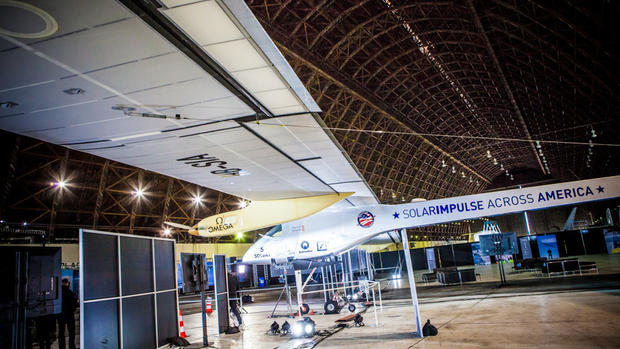Solar-powered plane to make cross-country flight
Solar impulse, an ultra-lightweight plane powered completely by the sun is set to fly coast-to-coast this spring, researchers announced today (March 28) at Moffett Air Field at NASA Ames Research Center in Mountain View, Calif.
The plane requires zero fuel and relies solely on solar panels and battery power.
The two Swiss pilots of the plane, Bertrand Piccard and Andre Borschberg, want to complete a flight from Moffett Field to New York City. Along the way it will stop in Phoenix, Ariz., Dallas-Ft. Worth, Washington, D.C., and either Nashville, Tenn., Atlanta, Ga., or St. Louis. The plane will embark on May 1and will arrive in the Big Apple by early July.
The plane, called Solar Impulse, has a wingspan equivalent to a 747 jetliner, the weight of a station wagon, and the power needs of a small scooter. The solar panels across its wings harness power from the sun during the day, and lithium-polymer batteries store that energy for overnight trips. A carbon-fiber material formed in a honeycomb structure makes up the bulk of the plane, which allows for its feather-weight. [See Images of Solar Impulse Plane]
In 2010, the Solar Impulse plane completed a 26-hour overnight flight and in 2012 flew from Switzerland to Morocco without any fuel.
Around the world
The team's ultimate goal is to fly around the world. But to do that, the team needs to fly continuously for five days, which the current plane isn't equipped for.
They would also need to find more efficient batteries and motors, as well as improve the plane's reliability, Borschberg said during a press conference.
"You have no time to do maintenance and no possibility to change parts," Borschberg said of an around-the-world trip.
Borschberg and co-pilot Bertrand Piccard have spent 10 years designing the plane. Piccard is known for his flying adventures: in 1999 Piccard traveled around the world in a hot air balloon.
In its current from, the Solar Impulse is far from having any practical applications. The plane travels at a leisurely cruising speed that's lower than the highway speed limit in the United States and can hold just one passenger in a cramped cockpit.
But whereas the idea of using solar-powered planes for commercial flights sounds far-fetched, it's hard to say what the future holds, Piccard said in the press conference.
"Today, we cannot imagine having a solar-powered airplane with 200 passengers," Piccard said. But when the Wright brothers took flight in 1903 "it was exactly the same, and when Charles Lindberg crossed the Atlantic, he was all alone with an airplane full of gasoline."
Follow Tia Ghose on Twitter @tiaghose. Follow LiveScience @livescience, Facebook & Google+. Original article on LiveScience.com.
9 Totally Cool Uses for Drones
10 Future Public Transportation Vehicles
Creative Genius: The World's Greatest Minds
Copyright 2013 LiveScience, a TechMediaNetwork company. All rights reserved. This material may not be published, broadcast, rewritten or redistributed.
